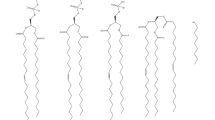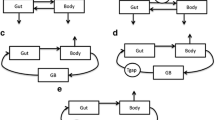Abstract
A recirculation model of drug disposition is used to interpret the physiological meaning of the variance of residence time distribution (VDRT). The pharmacokinetic parameter VDRT is determined by the means and variances of the transfer times across the organs, as well as by the respective blood flow and extraction ratios. The model is illustrated for a specified distribution of organ transit times assuming flow limited mass transport. Based on data from the literature, the influence of changes in cardiac output and its regional distribution on the variance of recirculation and residence times, respectively, is predicted for lidocaine. Thereby the study is focused on the effect of certain cardiovascular states (shock, hypoxia, exercise, sympathomimetic drugs). Unlike pharmacokinetic parameters derived from the zeroth and first curve moments, the relative residence time dispersion is found to be affected by a redistribution of the blood flow among the noneliminating organs. The equations presented allow a simple and rapid calculation of clinically relevant pharmacokinetic parameters from physiological and physicochemical data.
Similar content being viewed by others
References
K. Yamaoka, T. Nakagawa, and T. Uno. Statistical moments in pharmacokinetics.J. Pharmacokin. Biopharm. 6:547–558 (1978).
L. Z. Benet and R. L. Galeazzi. Noncompartmental determination of the steady-state volume of distribution.J. Pharm. Sci. 68:1071–1974 (1979).
M. Weiss and W. Förster. Pharmacokinetic model based on circulatory transport.Eur. J. Clin. Pharmacol. 16:287–293 (1979).
J. M. Van Rossum and C. A. M. Van Ginneken. Pharmacokinetic systems dynamics. In E. Gladtke and H. Heimann (eds.),Pharmacokinetics, G. Fischer Verlag, Stuttgart, 1980.
M. Weiss. Residence time and accumulation of drugs in the body.Int. J. Clin. Pharmacol. 19:82–85 (1981).
G. R. Wilkinson. Pharmacokinetics of drug disposition: hemodynamic considerations.Annu. Rev. Pharmacol. 15:11–27 (1975).
N. L. Benowitz and W. Meister. Pharmacokinetics in patients with cardiac failure.Clin. Pharmacokin. 1:389–405 (1976).
R. L. Williams and L. Z. Benet. Drug pharmacokinetics in cardiac and hepatic disease.Annu. Rev. Pharmacol. Toxicol. 20:389–413 (1980).
N. Benowitz, R. P. Forsyth, K. L. Melmon, and M. Rowland. Lidocaine disposition kinetics in monkey and man. I. Prediction by a perfusion model.Clin. Pharmacol. Ther. 16:87–98 (1974).
K. J. Himmelstein and R. J. Lutz. A review of the applications of physiologically based pharmacokinetic modeling.J. Pharmacokin. Biopharm. 7:127–145 (1979).
M. Weiss. Moments of physiological transit time distributions and the time course of drug disposition in the body.J. Math. Biol,15:305–318 (1982).
D. J. Cutler. A linear recirculation model for drug disposition.J. Pharmacokin. Biopharm. 7:101–116 (1979).
D. P. Vaughan and I. Hope. Applications of a recirculatory stochastic pharmacokinetic model: limitations of compartmental models.J. Pharmacokin. Biopharm. 7:207–225 (1979).
G. W. Roberts, K. B. Larson, and E. E. Spaeth. The interpretation of mean transit time measurement for multiphase tissue systems.J. Theor. Biol. 39:447–475 (1973).
K. B. Bischoff and R. L. Dedrick. Thiopental pharmacokinetics.J. Pharm. Sci. 57:1346–1357 (1968).
K. B. Bischoff, R. L. Dedrick, D. S. Zaharko, and J. A. Longstreth. Methotrexate pharmacokinetics.J. Pharm. Sci. 60:1128–1133 (1971).
L. I. Harrison and M. Gibaldi. Physiologically based pharmacokinetic model for digoxin disposition in dogs and its preliminary application to humans.J. Pharm. Sci. 66:1679–1683 (1977).
M. Rowland, L. Z. Benet, and G. G. Graham. Clearance concepts in pharmacokinetics.J. Pharmacokin. Biopharm. 1:123–135 (1973).
K. S. Pang and M. Rowland. Hepatic clearance of drugs. I. Theoretical considerations of a “well-stirred” model and a “parallel tube” model. Influence of hepatic blood flow, plasma and blood cell binding, and the hepatocellular enzymatic activity on hepatic drug clearance.J. Pharmacokin. Biopharm. 5:625–653 (1977).
N. Benowitz, R. P. Forsyth, K. L. Melmon, and M. Rowland. Lidocaine disposition kinetics in monkey and man. II. Effect of hemorrhage and sympathomimetic drug administration.Clin. Pharmacol. Ther. 16:99–109 (1974).
H. Adachi, H. W. Strauss, H. Ochi, and H. N. Wagner, Jr. The effect of hypoxia on the regional distribution of cardiac output in the dog.Circ. Res. 39:314–391 (1976).
S. F. Vatner and M. Pagani. Cardiovascular adjustments to exercise: hemodynamics and mechanisms.Progr. Cardiovasc. Dis. 19:91–108 (1976).
P. D. Thomson, K. L. Melmon, J. A. Richardson, K. Cohn, W. Steinbrunn, R. Cudihee, and M. Rowland. Lidocaine pharmacokinetics in advanced heart failure, liver disease, and renal failure in humans.Ann. Intern. Med. 78:499–508 (1973).
T. J. Knopp, W. A. Dobbs, J. F. Greenleaf, and J. B. Bassingthweighte. Transcoronary intravascular transport functions obtained via a stable deconvolution technique.Ann. Biomed. Eng. 4:44–59 (1976).
L. D. Homer and A. Small. A unified theory for estimation of cardiac output, volumes of distribution and renal clearances from indicator dilution curves.J. Theor. Biol. 64:535–550 (1977).
L. D. Homer and P. K. Weathersby. The variance of the distribution of traversal times in a capillary bed.J. Theor. Biol. 87:349–377 (1980).
W. G. Kramer, R. P. Lewis, T. C. Cobb, W. F. Forester, J. A. Visconti, L. A. Wanke, H. G. Boxenbaum, and R. H. Reuning. Pharmacokinetics of digoxin: Comparison of a two- and a three-compartment model in man.J. Pharmacokin. Biopharm. 2:299–312 (1974).
M. Weiss. Modelling of initial distribution of drugs following intravenous bolus injection.Eur. J. Clin. Pharmacol.,24:121–126 (1983).
Author information
Authors and Affiliations
Rights and permissions
About this article
Cite this article
Weiss, M. Hemodynamic influences upon the variance of disposition residence time distribution of drugs. Journal of Pharmacokinetics and Biopharmaceutics 11, 63–75 (1983). https://doi.org/10.1007/BF01061768
Received:
Revised:
Published:
Issue Date:
DOI: https://doi.org/10.1007/BF01061768




